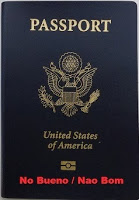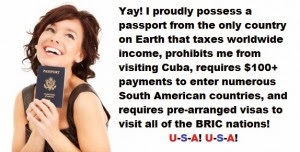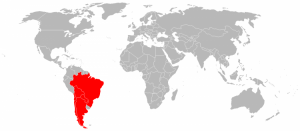 |
| U.S. passport stamped with “Not Good” in Spanish and Portuguese |
Digby Jones
Activist Post
This may come as a big surprise to citizens of the United States, or “America” as a huge percentage of the populace (and the majority of jingoistic politicians) incorrectly like to call it. Your passports, which represent what is supposed to be the most free nation on Earth, is the most restrictive piece of documentation among developed countries to travel freely in . . . well . . . a huge chunk of America!
A combination of antiquated ideological embargoes, less than cordial international relations, and harsh reciprocity regarding arrival procedures and visas, require U.S. passport holders to pay to enter more Latin American countries than any other developed nation. Indeed, the true value of a U.S. passport is called into question when it is such an underprivileged document for travelling in a significant part of its own hemisphere. By comparison, most European countries in addition to Canadians, Australians, Kiwis, Japanese, Koreans, and Singaporeans are all afforded a higher degree of travel freedom to the same region. Specifically in the case of Europeans and New Zealanders, their passports are significantly better for Latin American travel.
The most prominent, and indeed the saddest example of U.S. passport inferiority for extensively travelling Latin America is among the closest to home. It is none other than the beautiful island nation of Cuba, and we are essentially banished from being able to visit this country for the crime of being born or naturalized as a U.S. citizen. Literally every other nation on Earth is afforded the liberty to visit and experience the captivating culture and astounding natural beauty of this large Caribbean country, provided they go through the standard visa procedures and so forth (it is fairly routine for most countries).
However, a few exceptions aside (Americans have been tossed small bones in recent years by being able to visit as part of strictly regulated religious, educational, and cultural groups. However, they are applicable to only niche segments of the U.S. population and grant very little personal freedom to move about and interact with everyday Cubans) U.S. passport holders possess the uncomplimentary distinction of being the only country in the world which is banished from visiting Cuba by decree of their own government’s antiquated embargo. Those who choose to visit Cuba “illegally” risk very harsh financial and judicial prosecution on their return home to the ‘land of liberty’, for their oh-so-unspeakable crime of travelling and enjoying the large offshore island. They will be punished for befriending and sharing positive energy with its residents, as admirable and open-minded global citizens.
In January 2012, an Angus Reid Public Opinion poll showed 57% of Americans called for ending the travel ban that prevents most Americans from visiting Cuba. Personally, I think that’s 43% not enough.
It’s a stupid policy. There’s no reason why we can’t be friends with the Cubans, and vice versa. A lot of them have relatives in the United States, and some Americans have relatives in Cuba, so we should have freedom of travel … We seem to think it’s safe to open the door to a billion communists in China but for some reason, we’re scared to death of the Cubans. – former Democratic presidential candidate George McGovern (June, 2011)
Brazil
 Brazil is a monster among nations, comprising 51% of the population of South America and a comparable amount of its total land area. In fact, it is the world’s fifth largest country by both territory and population, and it represents the big “B” among the emerging BRIC nations. The country has been flexing it’s growing economic muscle in the 21st century, and it has shown that it does not like being pushed around by the arrogant and “exceptional” policies of the United States without fitting diplomatic retribution.
Brazil is a monster among nations, comprising 51% of the population of South America and a comparable amount of its total land area. In fact, it is the world’s fifth largest country by both territory and population, and it represents the big “B” among the emerging BRIC nations. The country has been flexing it’s growing economic muscle in the 21st century, and it has shown that it does not like being pushed around by the arrogant and “exceptional” policies of the United States without fitting diplomatic retribution.
Brazil’s president Dilma Rousseff is a prominent figurehead in the implementation of the BRICS Cable, which is designed to rid numerous influential countries from the scourge of creepy NSA eavesdropping, while Brazil is also one of a number of countries that retaliate’s on US citizen visa applications with corresponding reciprocity fees. That’s right, U.S. citizens must now pay a whopping $180 for a visa to visit the largest and most populous nation in Latin America while many other culturally similar nations do not require any visa or monetary payment whatsoever.
By comparison, citizens of the European Union, New Zealand, and South Korea are allowed to freely come and go to Brazil as they please. To get a feel for the consequences of needing a visa for this country, just look at a globe and fixate your eyes on Brazil for a little while. Come to the realization that U.S. citizens must go through an irritating visa process and pay a hefty fee to enter this massive and diverse country, knowing all the while that Europeans are in the clear. That simply does NOT look good for evaluating the advantages of a U.S. passport for travelling globally, let alone Latin America.
Argentina
Argentina is the world’s 8th largest nation and is comparable in size to India (oddly enough another major country which U.S. citizens need pre-arrival visas while some other western nations such as New Zealand are afforded more flexibility). Along with its smaller neighbor Uruguay, Argentina is the most European of Latin American nations. In fact, turning a common Anglo-American misconception of Latin America completely upside-down (that everyone south of the Rio Grande comes in various shades of brown), it may come as a surprise to many that modern day Argentina and Uruguay actually have the highest percentages of Caucasians in the Americas as a whole.
The country spreads from the sub-arctic town of Ushuaia, used as a gateway for Antarctic expeditions, to the thunderous tropical wonder that is the Iguazu Falls. Buenos Aires is a magnificent city full of beautiful french influenced architecture, raucous football matches, professional tango, pulsating nightclubs, and gorgeous residents. The country is quite affordable even with the weak U.S. dollar, has top-notch steaks and wine, and has terrific hiking and skiing around the beautiful lakes district. Considering the issue of safety, beyond a few bad-egg neighborhoods to avoid and simple precautions to take in the larger cities, the country is hardly any more dangerous for tourists than if you were visiting Nebraska. What’s not to love?
Well, as of 2013, citizens of the United States must now pay a huge $160 reciprocity fee to enter Argentina. The U.S. state department website wants to claim it’s due to a change in “Argentinian law”, as if the United States didn’t deserve it for some reason. But that is because Argentinians were subject to this harsh payment in order to enter the United States in the first place, and they are merely returning the “favor”. The consequence of this matter is that U.S. citizens are the ONLY country in the western world which requires a payment in order to travel or do business in Argentina. That means Europeans, Canadians, Australians, Kiwis, Japanese, Koreans, Israelis, etc. all get to visit Argentina with an extra $160 in their pocket to spend on luxurious cuts of beef, tasty Mendoza wine, football matches, or whatever else tickles their fancy. Dammit!
Chile
 There is a lot to love about Chile and things have changed a lot since the days of the Pinochet dictatorship. The country is clean, safe, and as of the 2010s, almost borderline 1st world in many respects. Chile beats the United States by ranking lower on the corruption perceptions index (ouch!), has a fairly low percentage of its population living in abject poverty, Santiago is a safer city than any U.S. metro area of comparable size, and the Chileans could teach Americans a thing or two about keeping a marriage intact (the divorce rate is among the world’s lowest).
There is a lot to love about Chile and things have changed a lot since the days of the Pinochet dictatorship. The country is clean, safe, and as of the 2010s, almost borderline 1st world in many respects. Chile beats the United States by ranking lower on the corruption perceptions index (ouch!), has a fairly low percentage of its population living in abject poverty, Santiago is a safer city than any U.S. metro area of comparable size, and the Chileans could teach Americans a thing or two about keeping a marriage intact (the divorce rate is among the world’s lowest).
While the capital itself is hardly a popular tourist destination, the country features the eerily beautiful Atacama Desert and the Torres Del Paine national park, probably one of the most majestic hiking and camping spots on the planet. But guess what? U.S. citizens must pay a Chilean visa reciprocity fee much like neighboring Argentina, which is currently set at $160. While the fee is only charged at the Santiago International Airport, you need to bear in mind that is the only major international airport for the entire country. So if you are getting sick of the United States and want to retire to Galt’s Gulch, the extra $160 you must pay to enter Chile on top of your expensive plane ticket is really rubbing salt in the wound.
Bolivia
Bolivia is just plain awesome. Don’t let anybody who gave you a horror story about how terrible the roads were deter you from visiting this special place. While unfortunately it’s the poorest country in South America, the country features fantastic tourist destinations in the form of the Uyuni salt flats, the ‘worlds most dangerous road’, and the cities of La Paz and Potosi. As for the progressive city of Cochabamba, located at an elevation which grants Spring-like weather year round, it would be as expensive and overdeveloped as Southern California if the city were located in the United States.
Several western countries do require tourist visas for Bolivia, and the United States is certainly no exception. A tourist visa currently costs $135, which is actually a very large amount of money considering how incredibly cheap the country is for most westerners. When I visited in 2009, I contributed the equivalent of five dollars for a shared taxi fare between the cities of Potosi and Salar de Uyuni, and spent several nights in a hotel near lake Titicaca for the equivalent of $2.15 per night (no typo). The room was hardly anything to brag about, but I got as good a night’s sleep as any other soulless $100-a-night chain hotel in the USA. Makes you think….
Paraguay
Paraguay is among the least visited nations in South America for western tourists, possessing no real ‘must see’ destinations compared to its larger neighbors, and with most of the country being dominated by agriculture and ranching. Well, unfortunately, that still doesn’t change the fact that U.S. citizens must pay a large fee to enter Paraguay while just about all Europeans don’t have to! The current fee set for U.S. passport holders is $160, and that’s $160 of cold hard cash that Europeans can keep while exploring the 406,752 square kilometers of American territory that encompasses Paraguay.
Final Notes
Considering how awful the United States government treats Latin America and needlessly meddles in their affairs, we should consider ourselves lucky that visa requirements are as generous as they are in their current state. The U.S. government is constantly working to undermine the government of Venezuela, added fuel to the narcotics wars in Colombia for decades, assassinated Ecuadorian leaders (Jaime Roldos Aguilera), and tried to privatize Bolivian water sources, among countless other cruel and imperialistic endeavors in the region. Not too long ago, Bolivia got so sick of McDonald’s they completely tossed the garbage fast-food chain out of the country.
More recently, the U.S. government forcibly landed Bolivian president Evo Morales’ plane during their ruthless hunt for humanitarian-of-the-year Edward Snowden. Shortly thereafter, Venezuelan president Nicholas Maduro’s jet was denied a flight path by the United States aviation authorities, as it would briefly travel over Puerto Rican airspace on the way to Europe. It was an act of purely childish malevolence which was meant to do nothing more than irritate Venezuela’s president for his offering of asylum to Mr. Snowden.
Yet U.S. citizens can still visit Venezuela and most of the Andean countries (Colombia, Ecuador, Peru) without a visa. Venezuela is desperately trying to shake its ‘dangerous’ image and does not want to add difficulty to a potential market of 300 million+ people from spending tourist dollars in the country, especially with Caracas being the closest South American capital city to the United States. Ecuador uses the U.S. dollar and receives a lot of tourism, foreign investment, and a growing number of retirees from the USA. No way does Peru want to stymie the hordes of U.S. tourism to the cash bonanza that is Machu Picchu by suddenly requiring a tourist visa to land in Lima.
However, the more southerly South American nations are not quite as dependent on U.S. tourist dollars as their more northerly brethren in addition to most of the Caribbean, Mexico, and the countries along the Central American isthmus. As a result, they have the flexibility to retaliate in kind with the visa restrictions that are placed on their own citizens when they wish to visit the United States. They know that if you want to visit Chile or Argentina, then you want to visit Chile or Argentina. It’s that simple.
But there is something that hurts the most in a psychological sense. It is knowing that we as U.S. citizens, who are supposed to love our high degrees of “freedom” and “liberty”, are placed on financial punishment to visit a contiguous area of 13,557,596 square kilometers of South American territory. It is territory that Europeans and other developed nations have to cross an entire ocean to reach, with either few or no visa restrictions once they arrive. On the other hand, it is territory that we could feasibly drive to from the Mexican border. We have the worst level of travel freedom in the Americas among developed countries. Talk about a wake up call.
This article first appeared on Ingenious Press. Follow us on our Facebook and Twitter pages for weekly updates on independent news and other alternative media. For a related article, please read “The United States government does not want Americans to travel abroad.”




Be the first to comment on "U.S. Passports Offer The Worst Level of Travel Freedom in Latin America among Developed Countries"